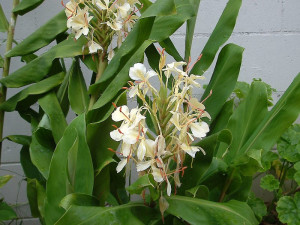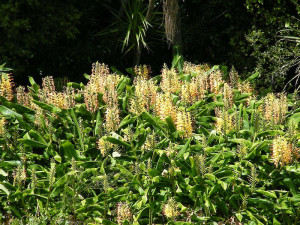Ginger is a fast-growing, long-living shade tolerant plant. It can form dense thickets and will eventually displace other native species. While the rhizome beds can spread out densely, they are shallow rooted, so when they become heavy with rain they can slip on steep sites and stream banks, causing erosion.
Despite its name, this tall vigorous perennial from India is not edible.
Both wild ginger species – kahili ginger (Hedychium gardnerianum) and yellow ginger (H. flavescens) – are sustained control pest plants in Golden Bay and Kaiteriteri. This means residents in these areas are responsible for control of these pest plants on their land.
Seeds are spread by birds and possibly possums. Rhizomes spread slowly outward from clumps. New plants can establish from rhizome fragments that are spread by dumped vegetation, soil movement, flooding, and contaminated machinery. Rhizomes can survive immersion in the sea, crushing, and years away from soil.
Control of this plant can be done all year, either by spraying or digging/pulling out small plants. For dense patches, keep the spray away from the roots of vulnerable plants. Don’t replant sprayed sites for six months, and don’t compost – leave it to rot down or hang rhizomes in trees, as they survive indefinitely. Dispose of rhizomes at a refuse station or by drying them out and burning them.
 If you need help or advice on controlling wild ginger, please contact our Biosecurity Team at biosecurity@tasman.govt.nz.
If you need help or advice on controlling wild ginger, please contact our Biosecurity Team at biosecurity@tasman.govt.nz.


